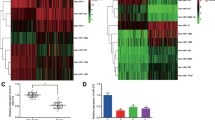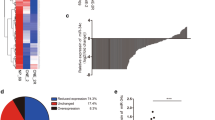Abstract
Objective
It has been studied that mesenchymal stem cells (MSCs)-derived exosomes could suppress tumor growth in nasopharyngeal carcinoma (NPC) and microRNA-181a (miR-181a) could mediate drug resistance in NPC. Focused on this work, the mechanism of human umbilical cord MSCs (hUC-MSCs)-derived exosomal miR-181a was explored in NPC cell progression.
Methods
NPC tissues and normal tissues were obtained from patients, and miR-181a and KDM5C expression was examined. hUC-MSCs-derived exosomes were extracted, identified and co-cultured with NPC cells (C666-1 and SUNE1). C666-1 cell progression in vitro and/or tumor growth in vivo were examined after incubation with exosomes, miR-181a or lysine-specific demethylase 5C (KDM5C). miR-181a and KDM5C expression were examined in NPC.
Results
miR-181a expression was reduced while KDM5C expression was elevated in NPC. hUC-MSCs-derived exosomes restrained NPC cell growth in vivo and in vitro. Depleting or restoring exosomal miR-181a promoted or delayed NPC cell progression. KDM5C silencing suppressed NPC cell progression.
Conclusion
This study concluded that hUC-MSCs-derived exosomal miR-181a retards NPC development via negatively modulating KDM5C, serving as a candidate reference for the therapy of NPC.





Similar content being viewed by others
References
Chan LS et al (2020) Role of miR-96/EVI1/miR-449a axis in the nasopharyngeal carcinoma cell migration and tumor sphere formation. Int J Mol Sci 21(15):5495
Dai Y et al (2019) miR-181a and miR-203 inhibit migration and invasion of laryngeal carcinoma cells by interacting with ATF2. Int J Clin Exp Pathol 12(1):133–141
Ding Y et al (2019) Exosomes derived from human umbilical cord mesenchymal stromal cells deliver exogenous miR-145-5p to inhibit pancreatic ductal adenocarcinoma progression. Cancer Lett 442:351–361
Duan HG et al (2015) Human umbilical cord mesenchymal stem cells alleviate nasal mucosa radiation damage in a guinea pig model. J Cell Biochem 116(2):331–338
Fu X et al (2020) Effects of cryopreservation and long-term culture on biological characteristics and proteomic profiles of human umbilical cord-derived mesenchymal stem cells. Clin Proteomics 17:15
Hao YR et al (2019) Long non-coding RNA ANRIL promotes proliferation, clonogenicity, invasion and migration of laryngeal squamous cell carcinoma by regulating miR-181a/Snai2 axis. Regen Ther 11:282–289
He Z et al (2020) Human umbilical cord mesenchymal stem cells-derived exosomes deliver microRNA-375 to downregulate ENAH and thus retard esophageal squamous cell carcinoma progression. J Exp Clin Cancer Res 39(1):140
Hong Z et al (2019) KDM5C is transcriptionally regulated by BRD4 and promotes castration-resistance prostate cancer cell proliferation by repressing PTEN. Biomed Pharmacother 114:108793
Hu J et al (2020) Human umbilical cord mesenchymal stem cell-derived exosomes suppress dermal fibroblasts-myofibroblats transition via inhibiting the TGF-beta1/Smad 2/3 signaling pathway. Exp Mol Pathol 115:104468
Huq S et al (2020) Repurposing the FDA-approved antiviral drug ribavirin as targeted therapy for nasopharyngeal carcinoma. Mol Cancer Ther 19(9):1797–1808
Ji X et al (2015) Lysine-specific demethylase 5C promotes hepatocellular carcinoma cell invasion through inhibition BMP7 expression. BMC Cancer 15:801
Jiang J et al (2019) miR-153-3p suppresses inhibitor of growth protein 2 expression to function as tumor suppressor in acute lymphoblastic leukemia. Technol Cancer Res Treat 18:1533033819852990
Li W et al (2020) A novel nomogram to predict survival in patients with recurrent nasopharyngeal carcinoma after salvage endoscopic surgery. Oral Oncol 111:104922
Liu Y et al (2018) Exosomes from mesenchymal stromal cells enhance imatinib-induced apoptosis in human leukemia cells via activation of caspase signaling pathway. Cytotherapy 20(2):181–188
Lv B et al (2020) The tumor-suppressive role of microRNA-873 in nasopharyngeal carcinoma correlates with downregulation of ZIC2 and inhibition of AKT signaling pathway. Cancer Gene Ther 28:74
Mao W et al (2019) Circular RNA hsa_circ_0068871 regulates FGFR3 expression and activates STAT3 by targeting miR-181a-5p to promote bladder cancer progression. J Exp Clin Cancer Res 38(1):169
Qiu L et al (2020) Exosomal microRNA146a derived from mesenchymal stem cells increases the sensitivity of ovarian cancer cells to docetaxel and taxane via a LAMC2mediated PI3K/Akt axis. Int J Mol Med 46(2):609–620
Shen H et al (2016) Suppression of enhancer overactivation by a RACK7-histone demethylase complex. Cell 165(2):331–342
Shi Q et al (2017) MiR-181a inhibits non-small cell lung cancer cell proliferation by targeting CDK1. Cancer Biomark 20(4):539–546
Sun HJ et al (2017) Activation of endocannabinoid receptor 2 as a mechanism of propofol pretreatment-induced cardioprotection against ischemia-reperfusion injury in rats. Oxid Med Cell Longev 2017:2186383
Wan FZ et al (2020) Exosomes overexpressing miR-34c inhibit malignant behavior and reverse the radioresistance of nasopharyngeal carcinoma. J Transl Med 18(1):12
Wang Q, Zhang W, Hao S (2017) LncRNA CCAT1 modulates the sensitivity of paclitaxel in nasopharynx cancers cells via miR-181a/CPEB2 axis. Cell Cycle 16(8):795–801
Wang HT et al (2019) MYCT1 represses apoptosis of laryngeal cancerous cells through the MAX/miR-181a/NPM1 pathway. FEBS J 286(19):3892–3908
Wang L, Zhang L, Wang L (2020a) SNHG7 contributes to the progression of non-small-cell lung cancer via the SNHG7/miR-181a-5p/E2F7 axis. Cancer Manag Res 12:3211–3222
Wang Q et al (2020ba) Comparison of induction chemotherapy plus concurrent chemoradiotherapy and induction chemotherapy plus radiotherapy in locally advanced nasopharyngeal carcinoma. Oral Oncol 111:104925
Wang J et al (2020cb) Exosome-transmitted long non-coding RNA SENP3-EIF4A1 suppresses the progression of hepatocellular carcinoma. Aging (Albany NY) 12(12):11550–11567
Wu SH et al (2020) Tetrandrine inhibits cell migration and invasion in human nasopharyngeal carcinoma NPC-TW 039 cells through inhibiting MAPK and RhoA signaling pathways. J Food Biochem 44:e13387
Xie K et al (2019) Exosomal miR-1246 derived from human umbilical cord blood mesenchymal stem cells attenuates hepatic ischemia reperfusion injury by modulating T helper 17/regulatory T balance. IUBMB Life 71(12):2020–2030
Yuan L et al (2019) Exosomes derived from microRNA-148b-3p-overexpressing human umbilical cord mesenchymal stem cells restrain breast cancer progression. Front Oncol 9:1076
Acknowledgements
We would like to acknowledge the reviewers for their helpful comments on this paper.
Funding
The financial reports of The Self-funded Research Projects of National Health and Family Planning Commission of Guangxi (NO. Z20170226); Basic Ability Improvement Project for young and middle-aged Teachers in Universities of Guangxi (NO. 2018KY0451); 2018 Guangxi scholarship Fund of Guangxi Education Department; Special Funding for Guangxi Special Experts (No. GRCT[2019]13#); Guangxi Medical High-level Leading Talents Training “139” Project (No. GWKJ[2018] 22#).
Author information
Authors and Affiliations
Corresponding author
Ethics declarations
Conflict of interest
The authors declare that they have no conflicts of interest.
Additional information
Publisher's Note
Springer Nature remains neutral with regard to jurisdictional claims in published maps and institutional affiliations.
Supplementary Information
Below is the link to the electronic supplementary material.
432_2021_3684_MOESM1_ESM.eps
Supplementary file1 (EPS 14520 KB) Supplementary Figure 1 hUC-MSCs-derived exosomes restrict SUNE1 cell growth in vitro. A. CCK-8 assay detected SUNE1 cell proliferation; B. Colony formation assay detected SUNE1 cell colony formation ability; C. Flow cytometry detected SUNE1 cell cycle; D. Flow cytometry detected SUNE1 cell apoptosis E. Transwell assay detected SUNE1 cell migration; F. Transwell assay detected SUNE1 cell invasion; the data in the figure were all measurement data, showing as mean ± standard deviation (n = 3). * P < 0.05 compared with the PBS group. The comparison between two groups was analyzed by independent sample t test.
Rights and permissions
About this article
Cite this article
Liu, J., Zhu, M. & Tang, Q. Human umbilical cord mesenchymal stem cells-derived exosomal microRNA-181a retards nasopharyngeal carcinoma development by mediating KDM5C. J Cancer Res Clin Oncol 147, 2867–2877 (2021). https://doi.org/10.1007/s00432-021-03684-6
Received:
Accepted:
Published:
Issue Date:
DOI: https://doi.org/10.1007/s00432-021-03684-6




